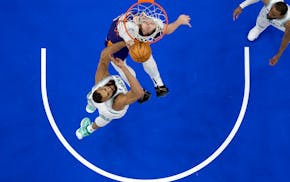I've been asked some version of a few questions multiple times recently, so this seemed like a good time to try to address them in one space:
• How much drop-off is there from Devan Dubnyk to Alex Stalock?
There's a reason Dubnyk is the starter and Stalock is the backup goalie for the Wild. Dubnyk has been a workhorse and draws a lot of tough assignments.
But when Stalock plays — and he might get more action in the coming days after relieving an injured Dubnyk in Tuesday's combined shutout of the Oilers — how much of a drop-off is there?
Dubnyk has a 2.36 goals-against average since joining the Wild, while Stalock sits at 2.77 in his Wild career. But a couple of stats show that in their time with the Wild, both goalies have been about equal in terms of keeping their team in the game.
Dubnyk has delivered a "quality start" — defined by Hockey Reference as having a better save percentage than the league average or topping 88.5% when facing fewer than 20 shots in a game — in 59% of his Wild starts. Stalock is very close to that at 58.1%.
Stalock also has delivered "really bad starts" (save percentage below 85) in just four of his 43 career Wild starts (9.3%). Dubnyk has slipped in that area in recent years. Since the start of 2017-18, 22 of his 132 starts (16.7%) have fallen into the "really bad" category.
• Will the Wolves have a more efficient offense this year?
After being dead last in the NBA two years ago in combined shots taken at the rim or from three-point range, the Wolves actually increased that mark by 7.8 percentage points last season (but still ranked near the bottom of the league at 60.3%).
This year, if they stick with their avowed preferred style, that number could vault closer to 75% and put the Wolves among the league leaders.
The Bucks made a similar leap from two years ago (60.7%) to last year (75.9%) and increased their win total by 16. If the Wolves did that this year, they'd blow even optimistic projections out of the water.
But it's not just as simple as shooting more efficient shots. For every Milwaukee and Houston (both among the top five in attempts at the rim/three-point line and effective field goal percentage last season, the latter of which takes into account three-point shooting), there were counterexamples like the Thunder and Nets who were in the bottom half of eFG% even though they were in the top 10 in efficient shot attempts.
Like any system, the personnel must match the idea. That will be the Wolves' greatest challenge this season, though improving on last year's 25th-ranked eFG% should be well within their reach.
• Why do two stats tell a much different story about Vikings QB Kirk Cousins?
Cousins heads into Thursday's home game against Washington with a passer rating this season of 114.3, tops among all qualified NFL quarterbacks. But his Total QBR is 57.6, ranking just 12th among quarterbacks.
What's up with that?
Well, passer rating is based solely on raw statistics: completions, attempts, yards, touchdowns and interceptions.
Total QBR, as developed by ESPN, attempts to factor in game situations, expected outcomes and other factors to evaluate a quarterback's impact on a particular game.
Cousins, for instance, posted decent overall numbers in a 16-6 loss to the Bears in Week 4, aided in part by good fourth-quarter numbers. So his passer rating was a respectable 91.5. But his Total QBR was a dismal 17.2, owing to missed throws and an overall negative result on high-impact plays.
His numbers were quite good in both categories each of the past three weeks — enough to boost him into the top overall spot in passer rating and at least get him into decent shape in Total QBR.

Souhan: Wolves fans made Game 1 special. Now bring on Game 2.

Will Wolves show best-in-the-NBA defensive form in Game 2?
NFL draft has been on tour for a decade and the next stop is Detroit, giving it a shot in spotlight

Former Totino-Grace star set to follow father as first-round pick

